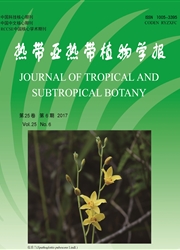

 中文摘要:
中文摘要:
研究了华南地区4种25年林龄的典型人工林土壤有机碳库及其稳定性特征。测定了林内0~10 cm和10~20 cm层土壤的有机碳(Total organic carbon,TOC)含量、易分解碳库/稳定性碳库大小以及土壤微生物生物量碳。结果表明,4种林型土壤TOC含量为:马占相思林〉大叶相思林〉湿地松林〉荷木林,其中豆科人工林(马占相思和大叶相思林)的TOC含量显著高于非豆科人工林(湿地松和荷木林)。在表土层(0~10 cm),荷木林易分解碳库最大(7.80 mg g-1),易分解性碳潜在周转时间最短(49 d),马占相思林易分解碳库最小(2.14 mg g-1),占总碳量也最小(8.63%),说明马占相思林土壤有机碳库比其它人工林具有更好的稳定性。4种人工林表土层土壤微生物量碳含量为马占相思林〉湿地松林〉大叶相思林〉荷木林,马占相思林显著高于其它3种人工林,表土层微生物量碳含量格局与土壤有机碳含量相似,较高的微生物量有利于更多的枯枝落叶转化为土壤有机碳。在亚表土层(10~20 cm),大叶相思林土壤微生物量碳最大,马占相思林最小,与表土层的格局相反,但亚表土层微生物碳总含量并不高。因而,人工林土壤有机碳积累水平与土壤有机碳的稳定性及表层土壤微生物量有关。
 英文摘要:
英文摘要:
The carbon stock and total organic carbon(TOC) stability in soils of four typical plantations at 25-year-old in South China were investigated.The TOC content,labile carbon pool and soil microbial carbon in soil depth of 0~10 cm and 10~20 cm were determined.The results showed that soil TOC contents were in order as Acacia mangium Acacia auriculaeformis Pinus ellettii Schima superba forest.Legume plantations(A.mangium and A.auriculaeformis) had markedly higher TOC content than non-legumes plantations(P.ellettii and S.superba).The TOC contents in two soil layers of A.mangium plantation were twice as high as those of S.superba plantation.S.superba plantation had the highest labile carbon pool(7.80 mg g-1) and the shortest turnover time(49 d).On the contrast,A.mangium plantation had the lowest labile carbon pool(2.14 mg g-1) and Clab/TOC(8.63%).A.mangium plantation had more stable TOC than other 3 plantations.The microbial carbon contents in surface soil layer(0~10 cm) were in order as A.mangium plantationP.ellettii plantationA.auriculaeformis plantationS.superba plantation.It suggested more microbes favored transformation of litter into soil organic matter.At the subsoil layer(10~20 cm),soil microbial carbon in A.auriculaeformis plantation was significantly higher than those in others forest types,though it was very low in this layer.A.mangium plantation had the lowest microbial carbon content.It suggested that soil TOC accumulation in plantations was closely related to stability of organic matter and quantity of soil microbes.
 同期刊论文项目
同期刊论文项目
 同项目期刊论文
同项目期刊论文
 The effects of vegetation types on soil properties and N transformations within 23 years forest rest
The effects of vegetation types on soil properties and N transformations within 23 years forest rest Seedling growth and soil nutrient availability in exotic and native tree species: implications for a
Seedling growth and soil nutrient availability in exotic and native tree species: implications for a The species-dependent responses of soil microbial community composition and respiration to fresh lea
The species-dependent responses of soil microbial community composition and respiration to fresh lea Effect of prescribed fire on soil properties and N transformation in two vegetation types in South C
Effect of prescribed fire on soil properties and N transformation in two vegetation types in South C Effects of root diameter and root nitrogen concentration on in situ root respiration among different
Effects of root diameter and root nitrogen concentration on in situ root respiration among different Effects of nitrogen-fixing and non-nitrogen-fixing tree species on soil properties and nitrogen tran
Effects of nitrogen-fixing and non-nitrogen-fixing tree species on soil properties and nitrogen tran Responses of photosynthetic parameters of Mikania micrantha and Chromolaena odorata to contrasting i
Responses of photosynthetic parameters of Mikania micrantha and Chromolaena odorata to contrasting i Structural and physiological responses of two invasive weeds, Mikania micrantha and Chromolaena odor
Structural and physiological responses of two invasive weeds, Mikania micrantha and Chromolaena odor Allelopathic effects of eucalyptus and the establishment of mixed stands of eucalyptus and native sp
Allelopathic effects of eucalyptus and the establishment of mixed stands of eucalyptus and native sp Stand level estimation of root respiration for two subtropical plantations based on in situ measurem
Stand level estimation of root respiration for two subtropical plantations based on in situ measurem Photosynthesis, chlorophyll fluorescence, and antioxidant enzymes responses of invasive weed Mikania
Photosynthesis, chlorophyll fluorescence, and antioxidant enzymes responses of invasive weed Mikania 期刊信息
期刊信息
